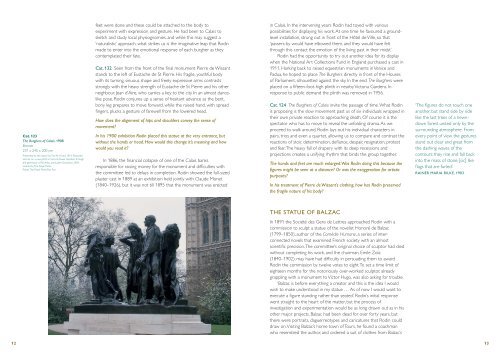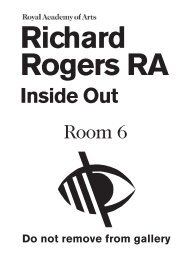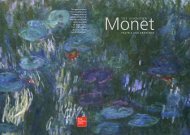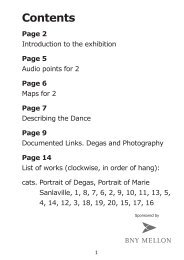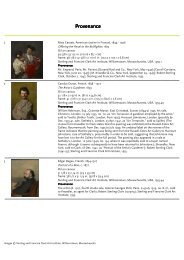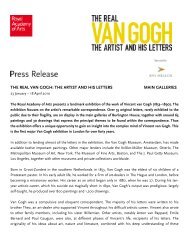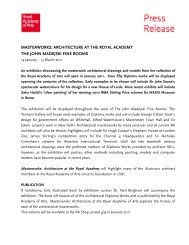rodin - Royal Academy of Arts
rodin - Royal Academy of Arts
rodin - Royal Academy of Arts
Create successful ePaper yourself
Turn your PDF publications into a flip-book with our unique Google optimized e-Paper software.
12<br />
Cat. 123<br />
The Burghers <strong>of</strong> Calais, 1908<br />
Bronze<br />
231 x 245 x 200 cm<br />
Presented to the nation by The Art Fund, 1914. Restored<br />
and set on a new plinth in Victoria Tower Gardens through<br />
the generosity <strong>of</strong> Nicholas and Judith Goodison, 2004.<br />
Loaned by The <strong>Royal</strong> Parks.<br />
Photo The <strong>Royal</strong> Parks/Roy Fox<br />
feet were done and these could be attached to the body to<br />
experiment with expression and gesture. He had been to Calais to<br />
sketch and study local physiognomies, and while this may suggest a<br />
‘naturalistic’ approach, what strikes us is the imaginative leap that Rodin<br />
made to enter into the emotional response <strong>of</strong> each burgher as they<br />
contemplated their fate.<br />
Cat. 132 Seen from the front <strong>of</strong> the final monument Pierre de Wissant<br />
stands to the left <strong>of</strong> Eustache de St Pierre. His fragile, youthful body<br />
with its turning, sinuous shape and freely expressive arms contrasts<br />
strongly with the heavy strength <strong>of</strong> Eustache de St Pierre and his other<br />
neighbour, Jean d’Aire, who carries a key to the city. In an almost dancelike<br />
pose, Rodin conjures up a sense <strong>of</strong> hesitant advance as the bent,<br />
bony leg prepares to move forward, while the raised hand, with spread<br />
fingers, plucks a gesture <strong>of</strong> farewell from the lowered head.<br />
How does the alignment <strong>of</strong> hips and shoulders convey the sense <strong>of</strong><br />
movement?<br />
In his 1900 exhibition Rodin placed this statue at the very entrance, but<br />
without the hands or head. How would this change it’s meaning and how<br />
would you read it?<br />
In 1886, the financial collapse <strong>of</strong> one <strong>of</strong> the Calais banks<br />
responsible for raising money for the monument and difficulties with<br />
the committee led to delays in completion. Rodin showed the full-sized<br />
plaster cast in 1889 at an exhibition held jointly with Claude Monet<br />
(1840–1926), but it was not till 1895 that the monument was erected<br />
in Calais. In the intervening years Rodin had toyed with various<br />
possibilities for displaying his work. At one time he favoured a groundlevel<br />
installation, strung out in front <strong>of</strong> the Hôtel de Ville, so that<br />
‘passers-by would have elbowed them, and they would have felt<br />
through this contact the emotion <strong>of</strong> the living past in their midst’.<br />
Rodin had the opportunity to try out another idea for its display<br />
when the National Art Collections Fund in England purchased a cast in<br />
1911. Harking back to raised equestrian monuments in Venice and<br />
Padua, he hoped to place The Burghers directly in front <strong>of</strong> the Houses<br />
<strong>of</strong> Parliament, silhouetted against the sky. In the end. The Burghers were<br />
placed on a fifteen-foot-high plinth in nearby Victoria Gardens. In<br />
response to public demand the plinth was removed in 1956.<br />
Cat. 124 The Burghers <strong>of</strong> Calais invite the passage <strong>of</strong> time.What Rodin<br />
is proposing is the slow movement past us <strong>of</strong> six individuals wrapped in<br />
their own private reaction to approaching death. Of course it is the<br />
spectator who has to move to reveal the unfolding drama. As we<br />
proceed to walk around, Rodin lays out his individual characters in<br />
pairs, trios and even a quartet, allowing us to compare and contrast the<br />
reactions <strong>of</strong> stoic determination, defiance, despair, resignation, protest<br />
and fear.The heavy fall <strong>of</strong> drapery with its deep recessions and<br />
projections creates a unifying rhythm that binds the group together.<br />
The hands and feet are much enlarged.Was Rodin doing this because the<br />
figures might be seen at a distance? Or was the exaggeration for artistic<br />
purposes?<br />
In his treatment <strong>of</strong> Pierre de Wissant’s clothing, how has Rodin preserved<br />
the fragile nature <strong>of</strong> his body?<br />
THE STATUE OF BALZAC<br />
In 1891 the Société des Gens de Lettres approached Rodin with a<br />
commission to sculpt a statue <strong>of</strong> the novelist Honoré de Balzac<br />
(1799–1850), author <strong>of</strong> the Comédie Humane, a series <strong>of</strong> interconnected<br />
novels that examined French society with an almost<br />
scientific precision.The committee’s original choice <strong>of</strong> sculptor had died<br />
without completing his work, and the chairman, Emile Zola<br />
(1840–1902), may have had difficulty in persuading them to award<br />
Rodin the commission by twelve votes to eight.To set a time limit <strong>of</strong><br />
eighteen months for the notoriously over-worked sculptor, already<br />
grappling with a monument to Victor Hugo, was also asking for trouble.<br />
‘Balzac is before everything a creator and this is the idea I would<br />
wish to make understood in my statue … As <strong>of</strong> now I would want to<br />
execute a figure standing rather than seated.’ Rodin’s initial response<br />
went straight to the heart <strong>of</strong> the matter, but the process <strong>of</strong><br />
investigation and experimentation would be as long drawn out as in his<br />
other major projects. Balzac had been dead for over forty years, but<br />
there were portraits, daguerreotypes and caricatures that Rodin could<br />
draw on.Visiting Balzac’s home town <strong>of</strong> Tours, he found a coachman<br />
who resembled the author, and ordered a suit <strong>of</strong> clothes from Balzac’s<br />
‘The figures do not touch one<br />
another, but stand side by side<br />
like the last trees <strong>of</strong> a hewndown<br />
forest united only by the<br />
surrounding atmosphere. From<br />
every point <strong>of</strong> view the gestures<br />
stand out clear and great from<br />
the dashing waves <strong>of</strong> the<br />
contours; they rise and fall back<br />
into the mass <strong>of</strong> stone [sic] like<br />
flags that are furled.’<br />
RAINER MARIA RILKE, 1903<br />
13


